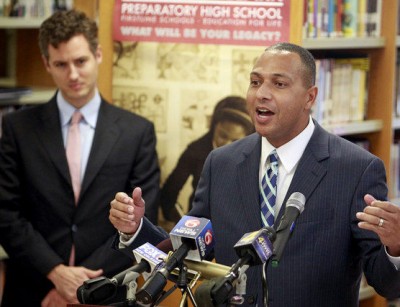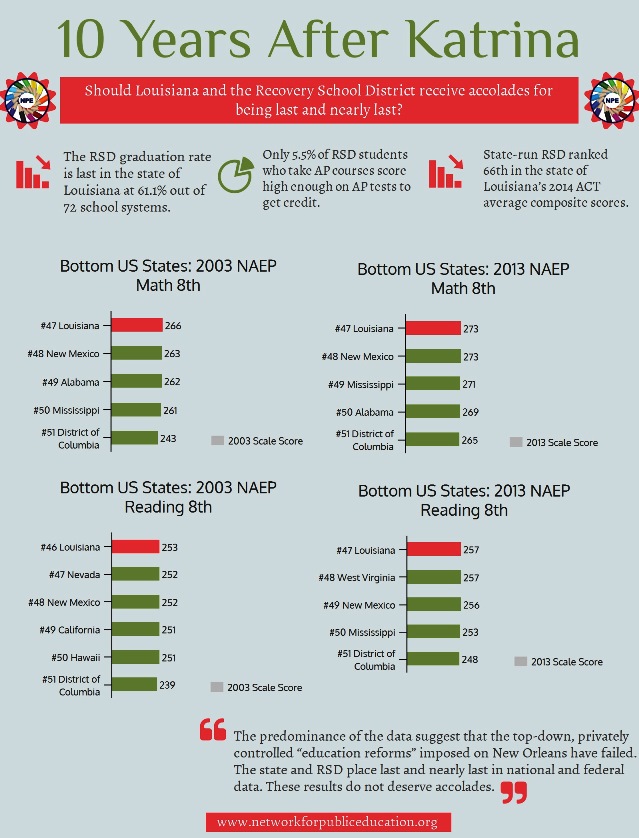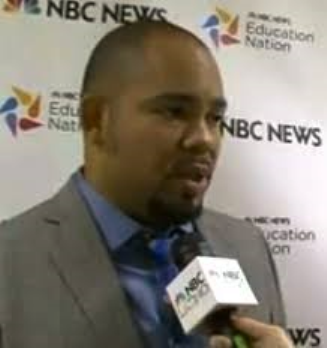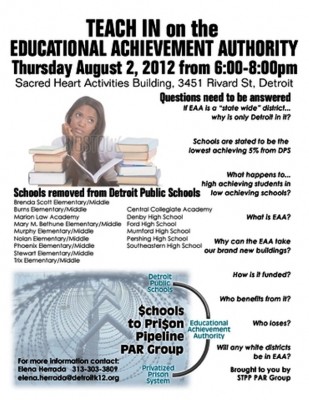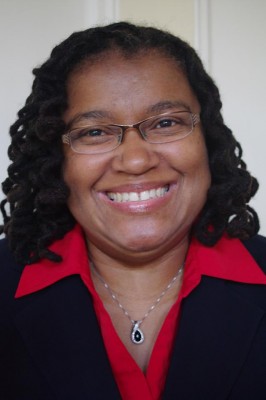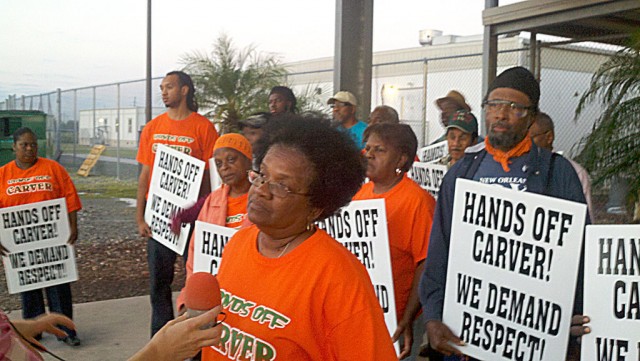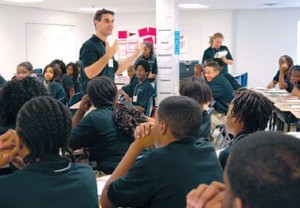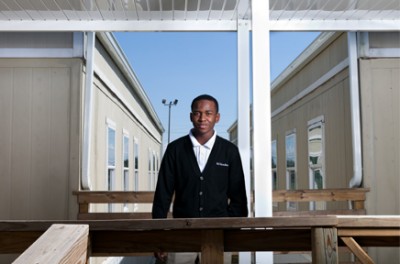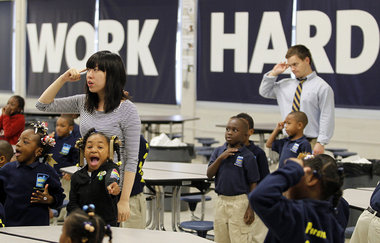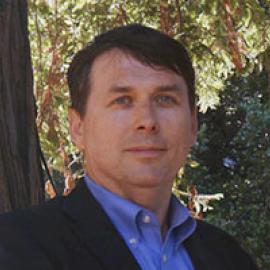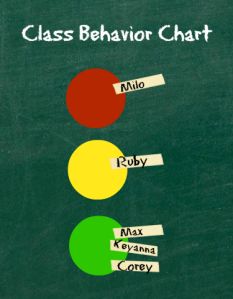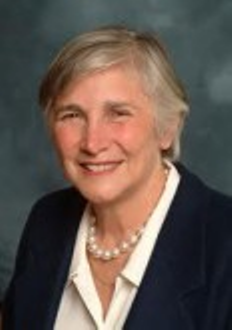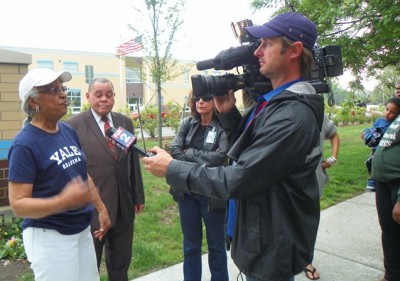
New Orleans public school bus submerged during Hurricane Katrina, a portent of how the state would use the flood to destroy public education in the city.
Test scores tell one story, and residents tell another. A three-month investigation by In These Times reveals the cracks in the education reform narrative.
(Photos, videos, graphics added by Voice of Detroit.)
August 28, 2015
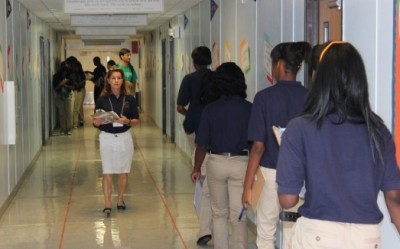
Carver Collegiate charter school students are only supposed to walk inside red lines on the floor, single-file, or face discipline.
Karran Harper Royal was pleased to be invited to join a citizens’ committee in 2006 to plan for the future of New Orleans schools. But she soon became disillusioned, convinced that the state didn’t really want citizen input—it already had a plan and was simply seeking approval.
Ninth grade was nothing like what Darrius Jones expected. Jones, 14, imagined that with high school would come more independence. Instead, he felt like he was being treated like a kid. “You had to sit a certain way,” he recalls. “You couldn’t lean, or have your chair back.” Jones says he stepped out of line once—an actual line on the floor of the hallway, which students were supposed to follow—and was sent to detention.
It was the beginning of the 2012 school year, and Jones was in the first class of students at Carver Collegiate Academy, a brand-new charter school in New Orleans’ Lower Ninth Ward. Like a public school, it is funded by taxpayers and open to anyone. But as a charter, it is managed independently by a board of directors that can do its own hiring and firing, write its own policies and teach according to its own philosophy. In the case of Carver Collegiate, that philosophy is one of “no excuses”—strict rules and swift discipline.
April 15, 2014: Parents file complaint against RSD Carver schools
Carver is part of New Orleans’ Recovery School District (RSD), the first all-charter school district in the nation. In the chaos after Hurricane Katrina, Louisiana opted to completely overhaul the city’s failing public schools by putting them on the open market. Ten years later, cities and states around the country have embarked on their own charter-school experiments and are watching New Orleans closely, laser-focused on outcomes.
Test scores have improved, according to two major reports that examine academic achievement over the past nine years. On Katrina’s 10th anniversary, RSD is being held up as a national model. The graduation rate has risen from 56 percent to 73 percent. Last year, 63 percent of students in grades 3-8 scored basic or above on state standardized tests, up from 33 percent.
But by other measures, the RSD suffers. In These Times received an advance copy of research conducted for the Network for Public Education (NPE) by University of Arizona researchers Francesca López and Amy Olson. The study compared charters in Louisiana, the majority of which are in New Orleans, to Louisiana public schools, controlling for factors like race, ethnicity, poverty and whether students qualified for special education. On eighth-grade reading and math tests, charter-school students performed worse than their public-school counterparts by enormous margins—2 to 3 standard deviations.
The researchers found that the gap between charter and public school performance in Louisiana was the largest of any state in the country. And Louisiana’s overall scores were the fourth-lowest in the nation.
“You can say until you’re blue in the face that this should be a national model, but this is one of the worst-perforing districts in one of the worst-performing states,” says NPE board member Julian Vasquez Heilig, an education professor at California State Sacramento.
(See Prof. Heilig’s report at http://www.networkforpubliceducation.org/2015/08/policy_brief_louisiana/.)
However, test scores, high or low, are only a piece of the story. In a three-month investigation, In These Times interviewed teachers, parents and students to find out how they feel about the charterization of public education in New Orleans.
Community members mourned the closures of public schools that had served as neighborhood hubs. Students at no-excuses charters described feeling like they were in prison, or bootcamp. Teachers felt demoralized, like they didn’t have a voice in the classroom. Parents complained about a lack of Black teachers. In interview after interview, people said the same thing: The system doesn’t put children’s needs first.
A swift takeover
Before Hurricane Katrina, New Orleans public schools were struggling. The graduation rate was 18 points below the national average. Sixty-eight percent of seventh and eighth graders were testing below basic proficiency in English, 70 percent in math.
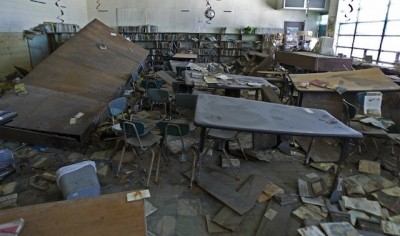
New Orleans public school classroom destroyed by Katrina. The state proceeded to dismantle the entire district afterwards.
After the hurricane hit in August 2005, the Orleans Parish School Board (OPSB) laid off some 3,000 staff and 4,000 teachers. More than half its physical infrastructure was damaged beyond repair, and its tax base was displaced.
The state of Louisiana then collaborated with corporate education reformers in the most expansive overhaul ever seen in the history of public education.
In November, the state legislature raised the bar for public schools to avoid takeover. With parts of the city still underwater, 107 of New Orleans’ 128 public schools were suddenly in the hands of the all-charter Recovery School District (RSD)—a two-year-old district that previously contained only five schools.
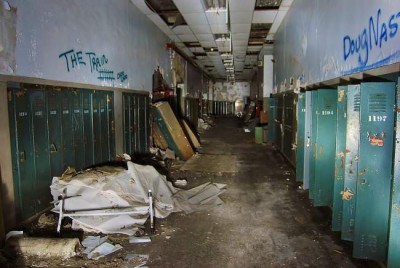
The remains of the historic original Cass Technical High School in Detroit. Most of Detroit’s public schools have been shut down using New Orleans as a model, driving thousands of students out of the district as charter schools profit. Detroit school closings began in 2005.
“Basically, we became the dog that caught the bus,” said Leslie Jacobs, a former member of the State Board of Elementary and Secondary Education and the woman widely known as the brains behind RSD, in an interview with the Washington Monthly. “We had nothing: no schools, no buildings, no cafeteria workers, no buses.”
What they did have was the backing of the national “education reform” movement, which pushes charters and high-stakes testing. With the public-school bureaucracy out of the way, powerhouses in the reform movement, such as the Walton and Gates foundations, came calling. In a 2006 interview with Education Next magazine, Mayor Ray Nagin put it this way: “They said, ‘Look, you set up the right environment, we will fund, totally fund, brand-new schools for the city of New Orleans.’ ”
And they did.
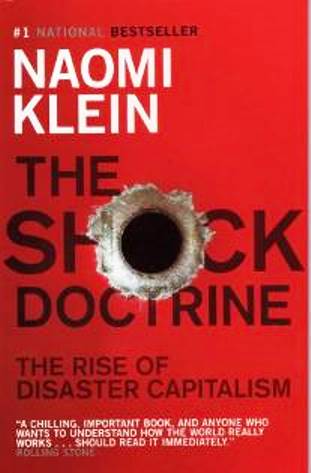 “In sharp contrast to the glacial pace with which the levees were repaired and the electricity grid brought back online, the auctioning-off of New Orleans’ school system took place with military speed and precision,” writes Naomi Klein in her landmark 2007 book The Shock Doctrine. She holds up the takeover as a prime example of “disaster capitalism”: “orchestrated raids on the public sphere in the wake of catastrophic events, combined with the treatment of disasters as exciting market opportunities.”
“In sharp contrast to the glacial pace with which the levees were repaired and the electricity grid brought back online, the auctioning-off of New Orleans’ school system took place with military speed and precision,” writes Naomi Klein in her landmark 2007 book The Shock Doctrine. She holds up the takeover as a prime example of “disaster capitalism”: “orchestrated raids on the public sphere in the wake of catastrophic events, combined with the treatment of disasters as exciting market opportunities.”
Today, RSD oversees 70 percent of the public schools in New Orleans. OPSB still contains 16 schools, the majority of which are now charters.
Each of RSD’s charter schools is like a school district unto itself. Although RSD regulates some things—for instance, that schools have open enrollment—charters are otherwise autonomous. They have their own boards, which set rules like length of school day, dress code and hiring practices, and their own management. In Louisiana and many other states, the board must be nonprofit. But management can be either nonprofit or for-profit.
Other states have followed Louisiana’s lead. In 2012, after Michigan Gov. Rick Snyder put Detroit under emergency management, the manager closed 16 city schools and handed 15 to the Education Achievement Authority, which received millions from the likes of the Kellogg and Gates foundations. In 2013, Tennessee created the Achievement School District to take over the state’s worst-performing schools; the district now runs 27 Memphis schools, 20 of them charters.
Others are sure to follow, as long as the narrative of charter success ‘holds. Education Secretary Arne Duncan declared, in 2010, that Katrina was “the best thing that happened to the education system in New Orleans.”
An anchor lost
To the community groups that filed a federal civil rights complaint in May 2014, the post-Katrina school reforms were “devastating.”
“The vast majority of public schools closed by RSD in the past five years were in poor and working class, African-American neighborhoods,” the complaint says. “Many of the schools existed for over a hundred years before being closed and had been attended by multiple generations in one family. These schools employed teachers and administrators who have taught in our communities for decades—staff who hold community knowledge, understand the hardships that face our students, and pass down our shared values. … After everything that we lost in Katrina, it has been devastating to lose our schools as well.”
Karran Harper Royal, a co-author of the complaint, is a former OSPB parent who was active in education politics before the storm. She was pleased to be invited to join a citizens’ committee in 2006 to plan for the future of New Orleans schools. But Royal soon became disillusioned, convinced that the state didn’t really want citizen input—it already had a plan and was simply seeking approval.
On a muggy afternoon in June, Royal drives me past the Desire housing project, where her great-grandmother lived. As a girl, Royal spent a lot of time here. The project now sits deserted, a graveyard of small brick homes boarded up in tall grass.
Most of the project’s residents were poor and black, and most attended George Washington Carver High School in the Lower Ninth Ward. Although Royal went to a different school, many people she grew up with went there: friends, cousins, her husband.
Carver was one of the “academically unacceptable” public schools transferred to RSD after Katrina. Though its test scores were low, locals nonetheless took pride in it. An award-winning example of mid-century modern architecture, Carver had a soaring auditorium and large cafeteria built to create a sense of a village. Its daycare center and music program were renowned citywide. Carver had a strong alumni network and served as an anchor for the neighborhood, bringing people together for football games and marching band performances. Its computer lab was an important resource for locals.
“Was it the best school in the city? No,” says Royal. “But did it produce great people? Yes, it did. Were there some people at Carver who didn’t make it? That’s true, too. Carver was in the middle of a very poor community.”
After the storm, RSD demolished Carver and built a modular campus in its place—portable classrooms connected by wooden boardwalks. Some alumni and community members formed George Washington Carver Charter School Association in a bid to charter the school themselves, but their three applications to RSD were turned down.
Instead, in 2012, RSD turned the school over to Collegiate Academies, considered a leading light of the charter movement. Its flagship school, Sci Academy, had opened in New Orleans in 2008 and seen significant gains in math and English within two years. Sci Academy was featured on The Oprah Winfrey Show, which awarded founder and CEO Ben Marcovitz a $1 million check.
Collegiate Academies is one of several growing charter networks in New Orleans modeled on what’s often referred to as the no-excuses approach. Disproportionately used in poor and minority communities, the model is characterized by longer school days (and years), frequent testing, and strict routines and behavioral codes enforced by demerit systems. Students can earn detention—and, eventually, suspension—for relatively small infractions.
In the 2012-13 school year, the three Collegiate Academies schools had the highest out-of-school suspension rates in New Orleans. Sci Academy suspended 58 percent of its students, and the two charters opened on the former Carver campus, Carver Prep and Carver Collegiate, suspended 61 and 69 percent of their students, respectively.
There isn’t yet a robust body of research on whether the no-excuses model encourages academic success. One widely cited analysis does show that children who were randomly selected to attend “no excuses” charter schools outperformed peers who weren’t.
But other research suggests that the approach produces good rule followers but poor critical thinkers. Princeton doctoral student Joanne Golann spent 18 months conducting fieldwork in a no-excuses charter school in a Northeastern city, interviewing close to one hundred students, teachers and administrators. She found that “students, in many cases, are taught to monitor themselves, hold back their opinions and defer to authority, rather than take initiative, assert themselves and interact with ease with their teachers.” She concluded that these “schools produce worker-learners to close the achievement gap.”
Rebellion in the ranks
When Rowena McCormick Robinson attended an orientation for prospective Sci Academy parents, it seemed promising. Officials assured her that the school offered advanced placement classes, extracurriculars and an atmosphere of strict discipline. The kind of place where her bright and quiet 14-year-old son, Russell, would thrive.
But within weeks of starting, the teenager, who normally woke up for school on his own, didn’t want to get out of bed. “I hate going there,” he told his mom. “It’s like prison.” When she heard about the rules the school was enforcing—rules about the way the kids had to sit, the way they raised their hand—she was furious.
These kids might be rowdy, she says, and many might come from dysfunctional homes, but they weren’t that bad. She thought it was wrong that so many were being punished as though they were delinquents.
Some of the students felt the same. Darrius Jones, who had been given detention for stepping out of line at Carver Collegiate, simply transferred schools. But in 2013, other kids at Carver Prep and Carver Collegiate started talking about a revolt. On Nov. 18, 2013, nearly 100 students walked out. They printed a list of 13 concerns, including, “We are learning material that we already learned in middle school” and “We want a discipline policy that doesn’t suspend kids for every little thing.”
Ben Marcovitz, CEO of Collegiate Academies, met with students and made a plan for reforms. Last year, Collegiate Academies launched a network-wide program focused on restorative discipline methods, instructing teachers to assume a student has just forgotten a rule and to take time to explain it. “We dropped our suspension rates from 56 to 12 percent in one year,” he says.
But the no-excuses approach shows no signs of going out of fashion. The rapidly growing charter network Knowledge is Power, for example, runs seven of RSD’s 80 charter schools under a no-excuses model, along with 176 more in “educationally underserved” communities across the country.
Younger, whiter and non-union
Another flashpoint in the Carver student protests was the racial makeup of the teaching staff. “There are no black teachers,” the complaint read. “The only black role models we have at the school are janitors, cafeteria workers, secretaries, security guards, and coaches.”
That bothered Rowena, too. The teachers at Sci, she says were “young and white” and didn’t understand anything about the culture. “There are a few who really care,” she says, “but they are thrown into this without knowing what they’re getting into.”
Collegiate made an effort to increase teacher diversity after the walkout, going from an 8 percent black teaching force to 30 percent.
Overall, however, New Orleans’ teaching landscape has shifted dramatically since Katrina. Before the storm, 73 percent of Orleans Parish’s classroom teachers were black. Nearly half of the teachers had been more than 15 years of experience. They were under a collective bargaining agreement with the United Teachers of New Orleans, an American Federation of Teachers affiliate.
After the OSPB layoffs, Teach for America (TFA), a nonprofit that trains college grads to teach in underprivileged communities, swept in to fill the gap, tripling the number of new recruits going to New Orleans.
The most recent teacher data available, from 2013, shows that the New Orleans teaching force is now 54 percent black, while the student body is 87 percent. The teachers are more likely than before the storm to come from an alternative certification program, such as TeachNOLA or TFA. RSD teachers average seven years of experience, OPSB charter teachers 12, and OPSB public school teachers 17. Only a few OPSB schools are unionized, and RSD is entirely non-union (although some organizing campaigns are underway).
Do these things matter? A 2005 study by Swarthmore researcher Thomas S. Dee found that teachers of a different race than a student were significantly more likely to evaluate that student as disruptive, inattentive and rarely completing homework.
Certainly, among New Orleans residents interviewed by In These Times, there was a sense that the loss of experienced black teachers has been detrimental to black students. Rowena’s mother, Roberta, taught art in a parochial school in Louisiana. “When I was a teacher, I was parenting,” she says. “What helped them so much was me being able to meet them where there were, with whatever they lacked, or needed extra. … These teachers, they’re not ready. For whatever reason, white folk fear black folks so much. They come in with the fear.”
A large body of research shows that teacher experience has a positive impact on student learning, especially after a teacher gets through the steep learning curve of the first three years.
Teacher retention has been a challenge for charter schools across the country. RSD charter schools in New Orleans have an average annual turnover of 27 percent. An analysis of National Center for Education Statistics by the University of Arizona’s López and Olson found that 46 percent of charter school teachers in Louisiana reported plans to leave, compared to 6 percent of public school teachers.
One of the main reasons that teachers leave a post, according to Richard Ingersoll, a University of Pennsylvania professor who studies teacher turnover, is the issue of “voice.” Teachers want to feel like they have a say in the classroom.
This was what bothered Kelly Pickett, one of the young, white teachers who started teaching in New Orleans after the storm. She’d been a chef for 10 years before going back to school at 28 to get her bachelor’s in early childhood education. Her first teaching post was in a first-grade classroom at Arthur Ashe Elementary, an RSD charter with a no-excuses approach. She’d known it was a strict school, but hadn’t fully understood how strict. She describes the experience as “horrible.”
The philosophy is “all about control,” she says. Teachers were instructed to keep students in the “STARR” position: Sit straight, Track the speaker with your eyes, And be Responsive and Respectful. Teachers had to post students’ test scores on the classroom walls. Bar charts showed where each student stood in comparison to the rest of the class and how much they needed to improve to raise the average so the whole class could win candy or a pizza party. The scores also helped determine teachers’ pay.
Pickett had to enforce a complicated system of warning and shout-outs on a behavioral stoplight at the front of the classroom. A student starts at green; two warnings move her to yellow; two more, she’s at red and out of the classroom. Positive “shout-outs,” move students in the other direction. Shout-outs are for things like helping a classmate or paying attention, and warnings for things like sitting improperly (not in STARR position) or for interrupting during a lesson.
Pickett disagreed with the rules, but had no choice but to enforce them.
“The kids are smart. Really smart,” Pickett says. “Some of them find their rewards in this system, others see no point and act out deliberatively to get out. They know exactly how to derail the system. I literally have to scream at them, and I hate it.”
After one semester, Pickett quit.
Some are more welcome than others
In the high-stakes education system in New Orleans, a no-excuses approach applies not just to individual students, but to schools. Those that fail to boost test scores can and do lose their charters.
According to a recent survey of 30 principals from both RSD and OSPB schools, many feel pressure to compete for the right kind of students.
The 2015 report, funded by the Education Research Alliance for New Orleans, found that about a third used means to screen out undesirable students (“creaming,” as the authors described it), even though this is technically not allowed under RSD’s open-admissions policy. One school stopped advertising open spots and enrolled 100 fewer kids, forgoing funding, rather than attract “less-capable students.”
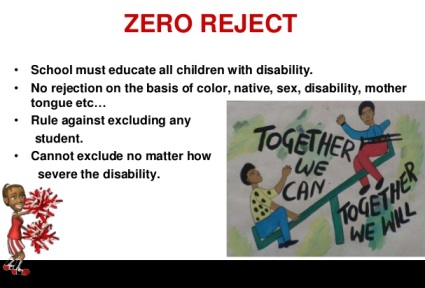 In other words, the report stated, “Some schools in New Orleans preferred to remain under-enrolled than to attract students who might hurt their test scores. … They viewed these practices as just part of their effort to create a coherent school culture or as a necessity for survival in a market-based environment.”
In other words, the report stated, “Some schools in New Orleans preferred to remain under-enrolled than to attract students who might hurt their test scores. … They viewed these practices as just part of their effort to create a coherent school culture or as a necessity for survival in a market-based environment.”
Among these practices have been illegal attempts to exclude special education students. This spring, Lagniappe Academies, an elementary school in New Orleans’ Treme neighborhood, lost its charter license after the state board of education found that administrators had deliberately screened out special needs students by refusing them services and creating a Do Not Call list of families they didn’t want to return the following year. Last year, Louisiana settled a suit filed by the Southern Poverty Law Center on behalf of 10 special-needs students in New Orleans schools—seven of which were charters—alleging that they’d been denied services and unfairly disciplined.
No-excuses charter schools around the country have been accused of disciplining underperforming students in order to push them out. Most deny that claim, but what’s clear is that their strict demerit systems lead to high expulsion rates.
Even if they’re not expelled, students leave New Orleans’ RSD schools at unusually high rates. At 61 percent, the graduation rate is the second-lowest in Louisiana. What happens to the other 39 percent? Only about 3 percent are listed as dropouts; the rest are listed as having switched schools or left the state. But no one really knows for sure. There’s no centralized database to track individual kids from K-12. Youth advocates say this makes it easy for kids to fall through the cracks. Fifiteen percent of New Orleans youth ages 16 to 19 aren’t working or in school, 6 points above the national average.
Rebuilding community power
The 10th anniversary of Katrina has sparked renewed interest in the New Orleans model. A recent Chicago Tribune editorial yearned for a hurricane to strike Chicago so that it, too, could have a “reset” to do away with “restrictive mandates” from government and demands from teachers unions.
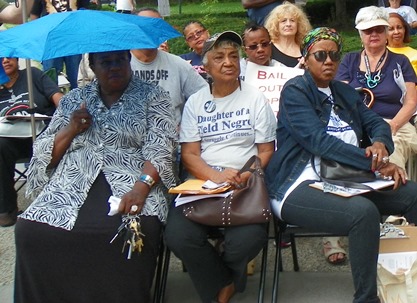
Long-time Detroit education activist Helen Moore (center), attended the New Orleans conference and reported back from it at a People’s Assembly in Detroit August 29, 2015. She is flanked by (l) former City Councilwoman JoAnn Watson and (r) Cecily McClellan, VP of the Detroit Active and Retired Employees Association (DAREA).
But the anniversary has also brought together the budding grassroots movement that’s fighting against the larger push for corporate education reform.
In early August, Kristen Buras, author of Charter Schools, Race, and Urban Space: Where the Market Meets Grassroots Resistance, helped organize a two-day conference in New Orleans on community-centered education research. Social justice advocates, educators and union leaders from 10 cities around the country came together out of concern about a loss of community control over schools. Most, not coincidentally, are from urban school districts with high poverty rates and large populations of students of color.
Many who have seen charters replace traditional public schools report the same problems that New Orleans residents describe: closures of public schools that held neighborhoods together, younger and less experienced teachers, the loss of union jobs, experimental teaching practics that can be rigid or harsh, cherrypicking of students and rapid teacher burn-out.
In an email to In These Times, New York University education professor and NPE founder Diane Ravitch summarized the emerging, less-rosy narrative of the New Orleans model, “That model requires firing all the teachers, no matter their performance, allowing them to reapply for a job, and replacing many of them with inexperienced TFA recruits. That model requires wiping out public schools and replacing them with privately managed schools that set their own standards for admission, discipline, expulsion, and are financially opaque. These heavy-handed tactics require a suspension of democracy that would not be tolerated in a white suburb, but can be done to powerless urban districts where the children are black and Hispanic.”
The good news, says Buras, is that, “Community-based activists experiencing this model are starting to connect with one another. The narrative is starting to change.”
Sarah Cobarrubias, Ethan Corey and Karen Gwee contributed research and reporting to this article.
This investigation was supported by the Fund for Investigative Journalism and the Leonard C. Goodman Institute for Investigative Reporting
Colleen Kimmett: Colleen Kimmett is a Canadian journalist who writes about social and environmental justice issues.
Related documents forwarded to VOD by Elder Helen Moore, head of the Keep the Vote No Takeover Coalition in Detroit for many decades.
NPE Louisiana policy brief_Vasquez Heilig
Louisiana Educator on RSD_Deshotels
Congressional Hearing Regarding School Restart Funds after Hurricane Katrina 12 noon Aug 10


